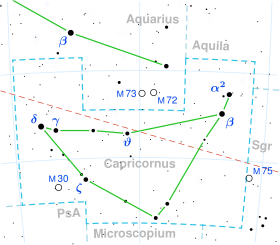| Observation data Epoch J2000.0 Equinox J2000.0 (ICRS) | |
|---|---|
| Constellation | Capricornus |
| Right ascension | 20h 27m 19.21088s[1] |
| Declination | −18° 12′ 42.1980″[1] |
| Apparent magnitude (V) | +5.096[2] |
| Characteristics | |
| Spectral type | B8 II-III[3] or B3-5 V[4] |
| U−B color index | −0.311[2] |
| B−V color index | +0.013[2] |
| Astrometry | |
| Radial velocity (Rv) | −13[5] km/s |
| Proper motion (μ) | RA: +16.914[6] mas/yr Dec.: −16.983[6] mas/yr |
| Parallax (π) | 4.9614 ± 0.3495 mas[6] |
| Distance | 660 ± 50 ly (200 ± 10 pc) |
| Absolute magnitude (MV) | −1.01[7] |
| Details | |
| π Cap Aa | |
| Mass | 5.9±0.1[8] M☉ |
| Luminosity | 238[9] L☉ |
| Temperature | 9,623[9] K |
| Rotational velocity (v sin i) | 30[10] km/s |
| Age | 43.4±7.8[8] Myr |
| Other designations | |
| Database references | |
| SIMBAD | data |
Pi Capricorni, Latinized from π Capricorni, is a triple star system in the southern constellation of Capricornus. It has the traditional star name Okul[citation needed] or Oculus (meaning eye in Latin).[12] This system appears blue-white in hue and is visible to the naked eye as a 5th magnitude star.[2] It is located approximately 660 light years distant from the Sun based on parallax,[6] but is drifting closer with a radial velocity of −13 km/s.[5]
In Chinese, 牛宿 (Niú Su), meaning Ox (asterism), refers to an asterism consisting of π Capricorni, β Capricorni, α2 Capricorni, ξ2 Capricorni, ο Capricorni and ρ Capricorni.[13] Consequently, the Chinese name for π Capricorni itself is 牛宿四 (Niú Su sì, English: the Fourth Star of Ox.)[14]
The primary member, component A, is a spectroscopic binary whose two components are separated by 0.1 arcseconds. The brighter of the two, component Aa, is a blue-white B-type bright giant or main sequence star with an apparent magnitude of +5.08. It is around 43 million years old with six times the mass of the Sun.[8] The star is radiating 238 times the Sun's luminosity from its photosphere at an effective temperature of 9,623 K.[9] The third member, component B, is an eighth magnitude star at an angular separation of 3.4″ from the primary.[15]
- ^ a b Cite error: The named reference
vanLeeuwen2007was invoked but never defined (see the help page). - ^ a b c d Cite error: The named reference
Rakos1982was invoked but never defined (see the help page). - ^ Cite error: The named reference
Cowley1972was invoked but never defined (see the help page). - ^ Cite error: The named reference
houk1988was invoked but never defined (see the help page). - ^ a b Cite error: The named reference
Wilson1953was invoked but never defined (see the help page). - ^ a b c d Cite error: The named reference
dr2was invoked but never defined (see the help page). - ^ Cite error: The named reference
Anderson2012was invoked but never defined (see the help page). - ^ a b c Cite error: The named reference
Tetzlaff2011was invoked but never defined (see the help page). - ^ a b c Cite error: The named reference
McDonald2012was invoked but never defined (see the help page). - ^ Cite error: The named reference
Abt2002was invoked but never defined (see the help page). - ^ Cite error: The named reference
SIMBADwas invoked but never defined (see the help page). - ^ Cite error: The named reference
oculuswas invoked but never defined (see the help page). - ^ (in Chinese) 中國星座神話, written by 陳久金. Published by 台灣書房出版有限公司, 2005, ISBN 978-986-7332-25-7.
- ^ (in Chinese) AEEA (Activities of Exhibition and Education in Astronomy) 天文教育資訊網 2006 年 5 月 13 日
- ^ Cite error: The named reference
wdswas invoked but never defined (see the help page).
